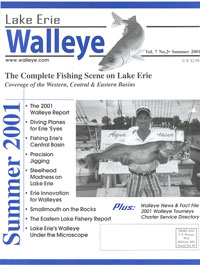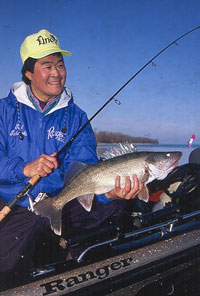Precision Jigging
by Ted Takasaki & Scott Richardson

Order Lake Erie Walleye Magazine
Three Information-Packed Issues for only $10.00
Delivered to your doorstep every March, June and September
|
Precision Jigging |
|
T
rolling is usually the ticket when it comes to catching walleyes on the Great Lakes. Spreading your lines and sifting through large areas of water fast will often connect you with active fish. But, trolling is not always the answer. Sometimes the situation calls for a presentation that lends itself to pinpoint accuracy. That’s when it’s time to turn to a jig.The decision on which presentation to choose – jigging vs. trolling - is
dictated by how the walleyes  are
relating to structure on any given day. Using electronics will tell you all you
need to know before you ever wet a line. Just ask yourself one question as you
watch the fish marks move across the sonar screen. Are walleyes dispersed over
huge areas or are they tightly schooled and holding close to reefs, points, rock
piles or weeds? Then picture which method, trolling or jigging, will keep your
bait in front of the most fish for the longest period of time.
are
relating to structure on any given day. Using electronics will tell you all you
need to know before you ever wet a line. Just ask yourself one question as you
watch the fish marks move across the sonar screen. Are walleyes dispersed over
huge areas or are they tightly schooled and holding close to reefs, points, rock
piles or weeds? Then picture which method, trolling or jigging, will keep your
bait in front of the most fish for the longest period of time.
Using this simple analysis, it becomes clear that trolling does the trick for walleyes that are scattered or suspended. This is normally true in the warm, summer months when walleyes are on the move in search of suspended baitfish. Vary the choice of crankbaits and the amount of line out or use a combination of snap weights and Lindy X-Change bottom bouncers with Hatchet Harnesses and live bait to cover the water column from top to bottom. In-line planer boards can spread your lines to cover a wide path.
Experience has taught us that walleyes will often hold tight to the bottom in small groups on the largest bodies of water. Rock piles, humps and reefs act like magnets in spring and fall or when cold fronts strike in places like Lake Erie’s Western Basin or Little Bay de Noc. At other times, walleyes will hold in dense cover, like the weed beds of Saginaw Bay. In all of these cases, trolling would put baits in the fish zone for only brief moments. You’d spend more time turning the boat around to make another trolling pass than you would actually fishing. On the other hand, specific spots can be worked precisely with a jig. Your bait will stay in front of a walleye for longer periods of time.
Here’s how
Doing your homework before you launch is an important ingredient to success on
any fishing trip. But on the Great Lakes, information gathering is absolutely
critical. There’s just too much water to have to search by yourself when armed
only with sonar and a rod and reel. Ask clerks at bait shops what areas and
tactics are producing. Have them mark your maps. Get the scoop on where the
largest concentrations of fish are and get GPS coordinates, if possible.
Once on the water, run from spot to spot, then cruise each location slowly.
Watch your sonar carefully to see how fish are relating to the available
structure and cover. Note the depth when you find a concentration of walleyes.
If they are suspended 3 to 5 feet or more off the bottom, break out the trolling
gear. If you are marking fish tight to structure, you’ll be using a jig and
live bait. When jigging, I like to use a 6-1/2 foot medium-heavy spinning rod
with a fast tip like Pinnacle’s Tri-Wing TI66SPMH. Your reel should be spooled
with 8 or 10 pound monofilament line, like Stren Super Tough, that can withstand
abrasions from zebra mussels and haul in the big fish typical of the Great
Lakes. Use a casting combination like the Pinnacle TI66CAMH for heavier jigs and
deeper water.
Mark the locations where you see fish on your GPS so you can return easily.
Check out the rest of the area and zig-zag slowly along structure contours and
weed edges at the depth where you first noticed fish. You might discover the
infamous spot-on-a-spot that holds an even larger school. When you do, enter the
GPS coordinates or toss out a marker buoy. In addition, listen to your marine
radio. Charter captains often exchange information and you might find a pattern
or another spot that can help you.
Successful jigging often demands a precise presentation well below the
surface. Your ability to accomplish that task depends on the conditions you face
above. Are the waves small or large? Can you hold your boat still with an
electric trolling motor? If so, you can literally drop a jig on a walleye’s
nose. A transducer on your trolling motor enables you to work your boat with
precision on the edges of the structure.
Golden Rule of Jigging
Here’s the number one Golden Rule of Jigging - your jig must always be on or near the bottom for it to be effective. You aren’t fishing high percentage, structure-oriented unless it is.
Common sense dictates that the shallower the fish or the slower the wind or current, the lighter the jig can be. An eighth or quarter ounce Fuzz-E-Grub jig can be cast to the top of a reef or hump topping out in a foot or two of water and retrieved slowly along the bottom back to the boat. For more finicky fish, dangle a smaller jig below a Thill Float so it rides just off the bottom. Let the waves impart the action. Jigs of three-eighths, a half or three-quarters of an ounce handle medium depths. A Jumbo Fuzz-E-Grub weighing five-eighths or an ounce can get down to 50 feet and more. (Ted once led the Professional Walleye Trail tournament on Lake Erie by using his trolling motor to thump big Fuzz E Grubs on humps that rose 5 feet from the bottom in 50 feet of water. His five fish weighed about 37 pounds.)
If the the waves make it too rough to control the boat with an electric motor, toss out an anchor or drift with the wind to cover large areas. Control boat speed with a drift sock, if needed. But whatever the situation, be sure to use a jig heavy enough to maintain bottom contact at all times. Keep no more than a 45-degree angle between your line and the water’s surface when drifting to avoid slack in your line and missed fish.
Minnows are great a bait for the Great Lakes anytime. Emerald shiners are the most common. Ask at the bait shops for what’s hot. Don’t be afraid to experiment, though. Try two minnows on the same hook. There are times when big walleyes seem to want big baits especially in fall and very early spring. Try larger minnows and longer plastic tails. Try a five-eighths or 1-ounce jig dressed with a 4 inch or 6 inch plastic lizard like the ones bass fishermen use. It works. Nightcrawlers and leeches work well as the water starts to warm up to above 50 degrees.
Sharpen hooks and bend out the hook gaps slightly to improve hook sets. Use stinger hooks, but sometimes allow it to remain free. Inserting the stinger’s barb into small emerald shiners can make it appear unnatural.
Jig action is crucial. That was made crystal clear one frigid day when Ted was fishing with walleye/muskie expert Jim Saric on Lake Erie. No one was catching anything, including the charter boats anchored nearby. But that changed when a chilly Saric cast a three-eighth-ounce Fuzz-E-Grub to the top of a 12-foot reef and let it fall to the bottom. As he reached for a cup of coffee, his shivering hand sent vibrations down his rod, through the line and to the jig. When he finally lifted the rod tip, a walleye was on. We took fish after fish during the next several minutes by duplicating the quivering motion. This proved that the first fish was no fluke.
What was the lesson? Match the action of a jig to fit the mood of the walleyes. The most common presentation is lift-drop, lift-drop. But try dragging it, popping it and letting it fall or holding it still just off the bottom. When casting to shallow reefs, let the jig drop until you feel the bottom or see slack in the line. Then slowly lift your rod tip 2 or 3 inches. Pause, drop your rod tip, reel up slack and let the jig touch bottom again. Repeat. Concentrate and remember what action you were giving the jig when you get your first strike. A common mistake by most jiggers is that they over jig. Use very subtle motions the majority of the time.
Color matters. As a general rule of thumb, brighter colors like chartreuse, lime-green or orange, are good in dirty or stained water. Try subtle, more natural colors like white, black, blue or purple for clearer water. Change up often until you find the color that the walleyes want.
Aggressive walleyes will really "thunk" a jig. If so, set the hook right away. But sometimes they will gently suck the bait in their mouth and just swim away. Get in the habit of watching your line. A few missed fish will alert you about whether you should "feed" them the jig and pause a little longer before driving home the point.
The Great Lakes are big - there’s no doubt about it. But, when the walleyes are concentrated and relating to structure, it time to jig with precision.